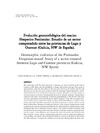Please use this identifier to cite or link to this item:
https://accedacris.ulpgc.es/jspui/handle/10553/9441
| Title: | Evolución geomorfológica del Macizo Hespérico peninsular:estudio de un sector comprendido entre las provincias de Lugo y Ourense (Galicia, NW de España) | Other Titles: | Geomorphic evolution of the Peninsular Hesperian massif : study of a sector situated between Lugo and Ourense provinces (Galicia, NW Spain) | Authors: | Vidal Romaní, J. R. Yepes, Jorge Rodríguez Martínez-Conde, R. |
UNESCO Clasification: | 250607 Geomorfología | Keywords: | Galician geomorphology Mesozoic Cainozoic Plate tectonics Basal Pyrenean Overriding, et al |
Issue Date: | 1998 | Journal: | Cadernos do Laboratorio Xeoloxico de Laxe | Abstract: | This paper deals with the relief generation in Ourense, an interior territory of the Galicia Country, at NW Spain, after the breakdown of Pangea 200 million years ago. The rupture of supercontinent causes the main effects in the outer part of Galicia, the present coast line and the shelf, but also the inner parts of Galicia where the landscape changes dramatically mainly ruled by fluvial incision connected with uprising, (orogenic, epirogenic, or isostatic origin), or even with eustatic oscillations, that shaped the previous old mesozoic landscape. Various things complicate the correct understanding of Galician geomorphology:1) the prevalent hercynian structure, (presumably reactivated during the Alpine Orogeny), causes that the epigenic processes, (fluvial, glaciar, marine and etching), acting on Galicia from Mesozoic to present times, produce end forms identified erroneously at the previous literature as tectonic and not as etch forms profiting from lithological or structural contrasts. 2) the common morphotectonic model accepted by all previous researchers establishes for the whole of Galicia a blocky pattern, (horst and graben like), due to extensional tectonic regime. This model is proved as no longer valid because the Galician tertiary basins, even were described at the past as graben depressions never have this origin. 3) big differences exist between the north and western sides of Galicia that show contrasted tectonic regime: compressional (with forms as the so called raised platforms), at the northern coast border, and extensional (with forms so typical as the Rias), at the western side. The study area is located at the confluence of two tectonic domains where the above mentioned effects are coincidents and specially well showed through different effects: prominent assimetry of fluvial captures (west facing), pronounced river incision and different kinds of tertiary basins: either strike slipe faults (Maceda, Xinzo de Limia, etc), or overslipped by inverse faults, (Quiroga, A Rúa, etc.), or even corresponding with depressions never, (or anywise passively), affected by tectonic movements, (Monforte). The paper include a detailed inventory of surfaces and terrace levels and their incision sequence which allow stablish a relative chronology of geomorphic evolution at this area of NW Spain during meso-cainozoic times. | URI: | https://accedacris.ulpgc.es/handle/10553/9441 | ISSN: | 0213-4497 | Source: | Cadernos do Laboratorio Xeolóxico de Laxe [ISSN 0213-4497], v. 23, p.165-199 | Rights: | by-nc-nd |
| Appears in Collections: | Artículos |
Page view(s)
112
checked on Aug 10, 2024
Download(s)
689
checked on Aug 10, 2024
Google ScholarTM
Check
Share
Export metadata
Items in accedaCRIS are protected by copyright, with all rights reserved, unless otherwise indicated.
